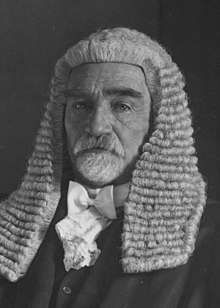Patrick Lynch (Australian politician)
Patrick Joseph Lynch (24 May 1867 – 15 January 1944) was an Australian politician who served as a Senator for Western Australia from 1907 to 1938. He was President of the Senate from 1932 to 1938. He began his career in the Australian Labor Party (ALP), but after the party split of 1916 joined the Nationalist Party and later the United Australia Party (UAP).
Patrick Lynch | |
|---|---|
 | |
| President of the Senate | |
| In office 31 August 1932 – 30 June 1938 | |
| Preceded by | Walter Kingsmill |
| Succeeded by | John Hayes |
| Minister for Works and Railways | |
| In office 14 November 1916 – 17 February 1917 | |
| Prime Minister | Billy Hughes |
| Preceded by | New office |
| Succeeded by | William Watt |
| Senator for Western Australia | |
| In office 1 July 1907 – 30 June 1938 | |
| Personal details | |
| Born | 24 May 1867 Skearke, County Meath, Ireland |
| Died | 15 January 1944 (aged 76) Mount Lawley, Western Australia, Australia |
| Political party | Labor (to 1917) Nationalist (1917–31) UAP (from 1931) |
| Spouse(s) | Annie Cleary ( m. 1901–1931)Mary Brown ( m. 1933) |
| Occupation | Engineer |
Early life
Lynch was born in Skearke, County Meath, Ireland and educated at Cormeen National School and Bailieborough Model School, County Cavan. He migrated to Queensland in 1886 and cut railway sleepers near Charleville and then travelled to the Croydon goldfields. In 1888 he started to work on ships operating along the Australian coast and in the South Pacific, eventually qualifying as a marine engineer. He worked as an engineer on a sugar plantation in Fiji and then on the Kalgoorlie goldfields in Western Australia. He helped found and Goldfields and Engine-drivers' Association and was its general secretary from 1897 to 1904. He married Annie Cleary in 1901.[1]
State politics
Lynch was a member of the Boulder Municipal District council from 1901 to 1904. He was elected unopposed for the Western Australian Legislative Assembly seat of Mount Leonora in 1904, representing the Australian Labor Party and became Minister for Works in the first Western Australian Labor government, led by Henry Daglish in June 1905, but it fell in August.[1]
Federal politics

Lynch was elected to the Australian Senate in the 1906 elections. In 1916, he became the first chairman of the River Murray Commission. During World War I, he was the first Federal Labor parliamentarian to advocate conscription and along with Billy Hughes, stopped attending the parliamentary caucus of the party on 14 November 1916. Hughes appointed him Minister for Works and Railways in his National Labor Party ministry that day, but he lost this position in the 17 February 1917 ministry to make room for a former Commonwealth Liberal Party member. He was expelled from the state branch of the Australian Labor Party in March 1917. He was President of the Senate from August 1932 to June 1938, but was beaten at the 1937 elections.[1]
Final years
Lynch married Mary Brown in 1933 after being widowed two years earlier. He ran unsuccessfully for the state seat of Geraldton in 1939. He died at Mount Lawley in 1944, survived by his wife and two daughters and a son of his first marriage.[1]
References
- Black, David (1986). "Lynch, Patrick Joseph (Paddy) (1867 - 1944)". Australian Dictionary of Biography. Melbourne University Press. ISSN 1833-7538. Retrieved 8 November 2007 – via National Centre of Biography, Australian National University.
Further reading
- Cusack, Danny (2002). With an Olive Branch and a Shillelagh: The Political Career of Senator Paddy Lynch (1867–1944) (PDF) (Ph.D. thesis). Murdoch University.CS1 maint: ref=harv (link)
| Political offices | ||
|---|---|---|
| Preceded by Sir Walter Kingsmill |
President of the Australian Senate 1932–1938 |
Succeeded by John Hayes |
| Preceded by New title |
Minister for Works and Railways 1916–1917 |
Succeeded by William Watt |